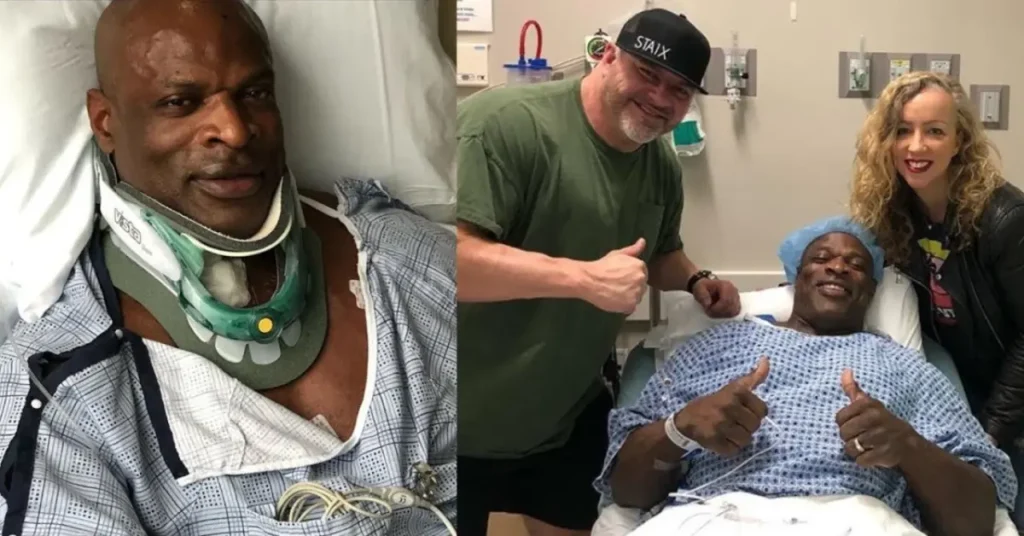In a raw, emotional, and deeply revealing interview aired on July 23, 2025, bodybuilding legend Ronnie Coleman opened up about the near-death experience that shocked the fitness world in June.
For the first time since being released from the hospital, the eight-time Mr. Olympia recounted the terrifying chain of events that led to him being intubated, placed in a medically induced coma, and fighting for his life—with his heart functioning at just 20%.
This wasn’t just another health scare.
This was septic shock—a life-threatening condition that nearly took the life of one of the greatest athletes in bodybuilding history.
⚠️ The Final Moments Before the Collapse
Ronnie Coleman, affectionately known as “The King,” recalled the last memories before everything went dark.
He had just finished a seminar and a meet-and-greet with fans—something he’s done countless times throughout his post-competitive career. But this time was different.
“I remember walking off… I got downstairs to my chair and then I’m like, okay, I got to do a meet and greet. I go out to do it… and Ron, I don’t remember doing the meet and greet.”
Something was wrong.
He became increasingly disoriented and irritable. After falling out of his wheelchair when he ran over a curb, paramedics arrived—just in time.
“They are like, man, you called us right at the nick of time. You’re in a lot of trouble there.”
Coleman was rushed to a hospital, where doctors discovered he was suffering from sepsis—a severe bloodstream infection that triggers a dangerous inflammatory response, leading to organ failure and death if not treated immediately.

💔 Septic Shock and a Failing Heart: “They Put Me in a Coma”
The situation worsened rapidly. Ronnie Coleman was transferred via helicopter to a specialized cardiac hospital, where doctors delivered the grim diagnosis:
“They put me in a lightweight coma, put this breathing tube down my throat.”
He was in septic shock, and his heart was operating at only 20% capacity—a critically low level that could have been fatal.
To stabilize him, doctors performed a minimally invasive heart procedure and kept him sedated while his body fought the infection. For days, his family waited anxiously, fearing the worst.
“Doctors did say that my heart had been working at 20%,” Coleman confirmed. “I ended up in septic shock, and I ended up getting that.”

🧠 A Wake-Up Call: “I Stopped Checking My Heart”
One of the most sobering revelations from Ronnie Coleman’s interview was his admission that he had stopped routine heart screenings for the past two years—despite having undergone over 13 surgeries on his back, spine, and neck.
“For the last 20-something years, I’ve been getting echocardiograms, ultrasounds, everything. Crazy me, I’m like, ‘Oh man, I’m alright. I don’t need all that hard stuff no more.’ And for two years, I didn’t do anything.”
That lapse, he now realizes, may have put his life at risk.
His message to fans and fellow athletes is clear:
Don’t ignore your health—even if you feel strong.
You can be the most powerful man in the room and still be vulnerable to silent threats like heart disease, sepsis, and organ failure.

🌟 The Road to Recovery: Still Fighting at 60
Despite the trauma, Ronnie Coleman remains as determined as ever.
Now home and beginning his recovery, he’s committed to physical therapy, pool workouts, cardio, and gym training—not to build muscle, but to regain mobility and independence.
“I don’t give up on that. I was going to therapy twice a week. I also get in the pool twice a week. I do a little pool work, along with my therapy, and all the other stuff. Been doing my workouts, my cardio. As soon as I leave therapy, I go straight to the gym.”
His ultimate goal?
To walk unassisted by 2027—a dream that still fuels his daily grind.
And while he uses a wheelchair, his spirit remains unbroken.
“Yeah buddy!”
“If it don’t challenge you, it don’t change you.”
Those iconic phrases aren’t just slogans—they’re his life philosophy.

🏆 A Legacy That Transcends the Stage
Ronnie Coleman’s influence on bodybuilding is unmatched. With eight consecutive Mr. Olympia titles (1998–2005), he redefined what was possible in terms of mass, symmetry, and conditioning.
But today, his legacy extends beyond trophies and stage wins. He’s become a symbol of resilience, a voice for health awareness, and a living reminder that even the strongest among us are human.
His popularity today, he says, surpasses even his competitive prime—not because of his physique, but because of his authenticity, humility, and willingness to share his struggles.

❤️ The Fitness World Stands Behind “The King”
Since news of his hospitalization broke, tributes have poured in from:
- Chris Bumstead
- Hadi Choopan
- Derek Lunsford
- Jay Cutler
- Dwayne “The Rock” Johnson
- Thousands of fans worldwide

The RONNIE STRONG initiative, launched by his team, continues to raise funds for Sepsis Alliance, aiming to educate and prevent future tragedies.
Coleman’s experience has become a cautionary tale and a call to action for athletes at every level.
🔥 Final Thoughts: Survival, Strength, and Second Chances
Ronnie Coleman’s story is no longer just about lifting heavy weights or winning titles.
It’s about survival.
It’s about waking up to your mortality.
It’s about fighting back—not with a barbell, but with determination, love, and medical care.
He’s survived more than a dozen surgeries, chronic pain, and now septic shock with near-fatal heart failure.
And yet, he’s still here.
Still smiling.
Still training.
Still inspiring.
Because for Ronnie Coleman, this ain’t nothin’ but a peanut.
